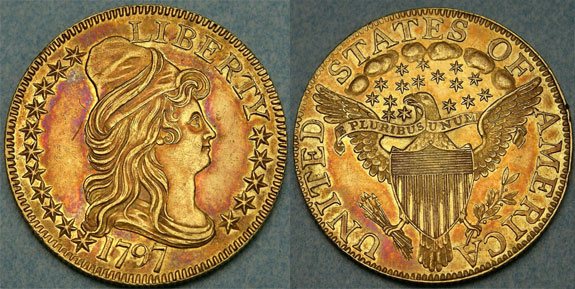Draped Bust Half Eagles
Source: My Coin Guides: The $5 gold denomination, or the half eagle, was the first gold coin struck for the United States of America. The initial series would come to be known as the Draped Bust Half Eagles, with the design sometimes referred to as “Turban Head” or “Capped Bust to Right”. Delivery of the first coins would take place on July 31, 1795, with the series continuing until 1807 in two different subtypes. All coins of the series had low mintages and heavy melting would take its toll. Locating problem-free examples with original surfaces and excellent eye-appeal can be difficult even for the most available dates.
The acquisition of a single circulated example represents a reasonable goal for most advanced type collectors. Building a full date and Red Book variety set, however, is much more difficult and might take a lifetime to complete. In fact, acquisition of all die varieties is currently impossible, as two major varieties are unique and permanently reside within the Smithsonian Institution’s National Numismatic Collection.

Under the Mint Act of1792, the gold half eagle was specified as the second highest denomination to be produced by the United States Mint, after the eagle which carried twice the value. However, when the latter was discontinued in 1804, the half eagle had established itself as the coin of choice for large domestic and overseas transactions. In commerce, the denomination was seldom encountered as the value of a single coin represented such a significant amount at the time. Many of the minted pieces were quickly exported overseas and later melted; those that did remain within the country only circulated among banks, and were unseen in daily commerce.
Like the other silver and gold denominations introduced in the mid-1790’s, the design for the Draped Bust Half Eagle was created by Robert Scot. Two subtypes would be minted between 1795 and 1807, identified by different reverse designs. For three years of the series in 1795,1797, and 1798, the two different reverse designs are known for each year.
The common obverse across both subtypes features a bust of Liberty, facing right. She wears a Phrygian or Freedom Cap, with her long and curlish hair seen extending beneath. A small part of her drapery is seen, slightly above the truncation of the neck. Stars are in front of her and behind her, in various counts and various arrangements. The word LIBERTY appears above the cap, with the date appearing slightly curved below the truncation of the neck. This same obverse design would be introduced across all three gold denominations introduced from 1795 to 1796.
The first reverse design, known as the “small eagle” subtype, was struck from 1795 to early 1798 and featured a relatively slim bald eagle seated on an olive branch with its wings spread. A wreath is held in its beak, with a number of small berries in various counts. The words UNITED STATES OF AMERICA appears surrounding the image, with IT in UNITED and ER in AMERICA separated by the ends of the wings.
Some time in mid-1797, a new reverse design was introduced, although this reverse is also found on three different 1795 varieties. The new reverse design featured a heraldic eagle, based on the Great Seal of the United States. Viewed from the front, the eagle’s wings are spread and a large shield is placed at its breast. The eagle’s talons grasp a bundle of arrows and an olive branch. In its beck is a scroll with E PLURIBUS UNUM, and above the head, between a single cluster of clouds are a number of stars, ranging in count from thirteen to sixteen, depending on the reverse die which was used.
